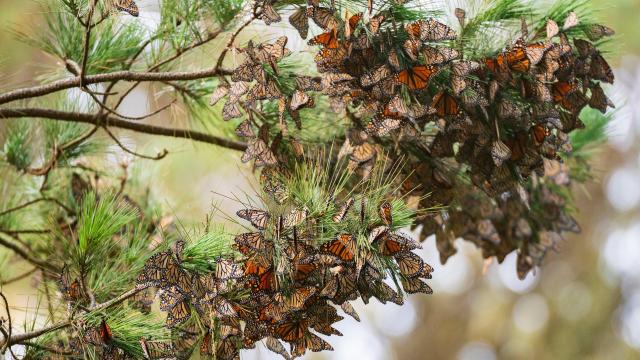California has been enduring a winter of wild weather, and it’s not just humans that have suffered for it. A new count of monarchs in the state turned up a disturbing low number of the endangered butterflies.
Governor Gavin Newsom declared a state of emergency this week as heavy snowfall blanketed the state. The latest extreme weather comes after a series of severe storms brought inches of rain, high winds, mountain snow, and flooding across California from mid-December through January.
Monarch butterflies, the striking orange-and-black insects renowned for their long-distance migrations, were pummelled by California’s December storms. The western subset of the endangered species spends the colder months overwintering in dense clusters in pockets of tree groves along the state’s coast. Between mid-November and early January, the number of butterflies counted there fell 58%, according to a report from nonprofit insect conservation group the Xerces Society, released Thursday.
For decades, Xerces has coordinated two in-depth counts of overwintering monarchs each year: one surrounding the Thanksgiving holiday and one surrounding New Year. In the most recent Thanksgiving count, the insects’ numbers were looking good. Volunteers tallied 335,470 butterflies — more than had been counted in any year since 2000, and a marked increase from the shockingly low sub-2,000 individuals that had been recorded in 2020.
Yet the number drop between November and January highlights just how fragile a population of hundreds of thousands of monarchs can be. It may sound like a high number, but 335,470 is a pittance compared to what western monarch populations once were. In the 1980s and 90s, millions of the insects congregated on the California coast each year. The population has declined more than 90% since then, according to Xerces estimates. The eastern population, which migrates to Mexico each winter, has also incurred steep declines of around 80%.
This butterfly disappearing act over just a few decades is thought to be the result of several factors. There’s human-caused climate change, which alters seasonal patterns that hurt migratory species especially hard. Pesticide use on agricultural land kills beloved insects as well as pests. Then, there’s a loss of milkweed acres, which monarchs rely on to complete their lifecycle, as well as deforestation and other habitat destruction.
Despite these ongoing challenges, there have been hopeful hints of possible monarch recovery over the past two years. In addition to the western monarch’s resurgence from fewer than 2,000 individuals to hundreds of thousands between 2020 and 2021, the eastern populations have been on the rebound, too. At the monarch overwintering site in Mexico, an annual survey of their extent found they were occupying 35% more space in 2022 than the year before, according to the World Wildlife Foundation.
But even as insect scientists celebrated these upticks, they warned that the situation remained tenuous. One bad year, and the butterfly populations could begin spiraling downward again. Which is effectively what’s happened this winter in California.
Usually, there is some decline in monarch numbers at western overwintering sites between November and January. Not all the butterflies make it through the whole season. But the average range of decrease is usually somewhere between 35% and 49%, according to Xerces, significantly lower than the 58% seen in the 2022-2023 season.
Though there were more monarchs in California’s groves this past November than the one before, by January that relationship had reversed. 2023’s New Year count recorded nearly 40,000 fewer insects than 2022’s. Volunteers participating in the butterfly count reportedly noted flooding, tree damage, and dead butterflies at many sites following winter storms.
“Small populations are particularly vulnerable to being snuffed out by extreme weather, so we are lucky these storms occurred in a relatively good year,” said Emma Pelton, a conservation biologist at the Xerces Society, in a statement. Unlike in 2020, nobody is talking about imminent extinction for the western monarchs this time around. But a few more bad years, and we could easily be back there again, Pelton suggested. “We don’t want to count on luck alone to ensure the survival of the western monarch migration.”
Though California routinely experiences atmospheric rivers in the winter months, some research suggests that climate change may be making such events more frequent and intense.
